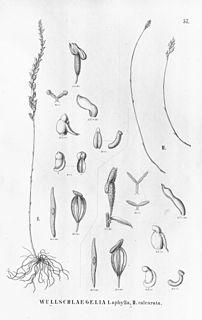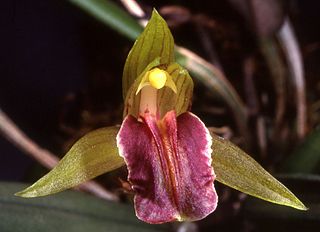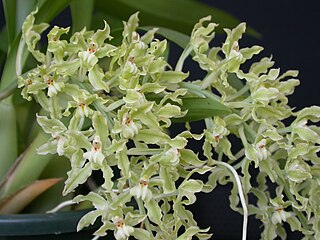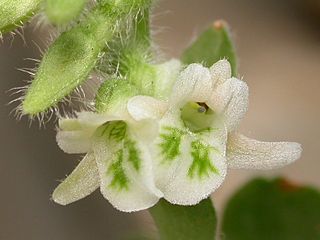
The Orchidaceae are a diverse and widespread family of flowering plants, with blooms that are often colourful and fragrant, commonly known as the orchid family.

The Pleurothallidinae are a neotropical subtribe of plants of the orchid family (Orchidaceae) including 29 genera in more than 4000 species.

Cypripedioideae is a subfamily of orchids commonly known as lady's slipper orchids, lady slipper orchids or slipper orchids. Cypripedioideae includes the genera Cypripedium, Mexipedium, Paphiopedilum, Phragmipedium and Selenipedium. They are characterised by the slipper-shaped pouches of the flowers – the pouch traps insects so they are forced to climb up past the staminode, behind which they collect or deposit pollinia, thus fertilizing the flower. There are approximately 165 species in the subfamily.
The taxonomy of the Orchidaceae has evolved slowly during the last 250 years, starting with Carl Linnaeus who in 1753 recognized eight genera. De Jussieu recognized the Orchidaceae as a separate family in his Genera Plantarum in 1789. Olof Swartz recognized 25 genera in 1800. Louis Claude Richard provided us in 1817 with the descriptive terminology of the orchids.. The next step was taken in 1830-1840 by John Lindley, who recognized four subfamilies. He is generally recognized as the father of orchid taxonomy. The next important step was taken by George Bentham with a new classification, recognizing subtribes for the first time. This classification was first presented in a paper that Bentham read to the Royal Society in 1881. Then it was published in 1883 in the final volume of Genera Plantarum. The next great contributors were Pfitzer (1887), Schlechter (1926), Mansfeld (1937), Dressler and Dodson (1960), Garay, Vermeulen (1966), again Dressler (1981). and Burns-Balogh and Funk (1986). Dressler's 1993 book had considerable influence on later work.

Broughtonia is a genus of orchids native to the Bahamas and the Greater Antilles. The genus is abbreviated Bro in trade journals.

Neocogniauxia is a genus of orchids,, consisting of two species in the Greater Antilles.

Dilomilis is a genus of orchids,, consisting of five species in the Greater Antilles.
Basiphyllaea is a genus of orchids, known as Carter's orchid or crab orchids. They are native to Florida and the West Indies. At the present time, 7 species are recognized:

Wullschlaegelia is a genus of orchids,, consisting of two species in the Caribbean Islands and to much of Latin America from southern Mexico to northern Argentina. These are myco-heterotrophic plants, lacking chlorophyll and subsisting entirely on nutrients obtained from soil fungi. The genus has previously been included in the tribe Calypsoeae, but is now included as the only genus in the tribe Wullschlaegelieae, pending further study.

Tolumnia, is a genus in the family Orchidaceae. Previously known as the "equitant Oncidiums", the species were segregated from the mega-genus Oncidium by Guido Braem in 1986. The plants are small, usually epiphytic, with small or absent pseudobulbs completely covered by leaves, which are triangular or circular in cross section and overlap each other at base to resemble a fan. The inflorescences arise between the leaf base and bear colorful, showy flowers. The labella are large, ornamented by variously shaped calli. The column bears prominent wings flanking the stigma. Dancing-lady orchid is a common name for some species in this genus.

Dendrophylax is a genus of leafless neotropical orchids native to Mexico, Central America, the West Indies, and Florida. The name is from Greek δένδρον ("tree") and φύλαξ. One species, Dendrophylax lindenii, featured heavily in the book The Orchid Thief.
Quisqueya is a genus of orchids,, consisting of four species endemic to the island of Hispaniola of the Greater Antilles. The genus was established in 1979 by Donald Dungan Dod. Its name is derived from the Taino name for Hispaniola.

Domingoa is a genus of orchids,, consisting of four currently recognised species at home in Mexico, Central America, Cuba, Hispaniola and Mona of the Greater Antilles. The genus was established in 1913 by Rudolf Schlechter. Its name refers to Santo Domingo, an older name for Hispaniola.
Entomophobia is a genus of flowering plants from the orchid family, Orchidaceae. Only one species is known, Entomophobia kinabaluensis, endemic to the Island of Borneo. The epithet "kinabaluensis" refers to Mount Kinabalu in Sabah.

Gomesa is a genus of flowering plants from the orchid family, Orchidaceae. It contains about 80–100 species, all native to South America.

Tetramicra is a genus of flowering plants in the orchid family, Orchidaceae, native to the West Indies. Tetramicra canaliculata has also been reported from southern Florida, but these reports have been challenged.

Lankesterella is a genus of flowering plants from the orchid family, Orchidaceae. It is found mostly in South America, with a few species extending north into Cuba, the Dominican Republic and Costa Rica.
Nothostele is a genus of flowering plants from the orchid family, Orchidaceae. It contains two known species, both endemic to Brazil.

Dr Maarten Joost Maria Christenhusz is a Dutch botanist, natural historian and photographer.

Dendrobieae is a tribe in the subfamily Epidendroideae, in the family Orchidaceae.















